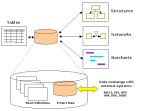The diagram above is a simplified representation of the database used by our products. As you can see, it contains a set of project data - calendar, task, resource and relationship information. This data can be created using the product itself or imported from other systems using a wide variety of data exchange channels.
Interaction with the information in the database is handled by the user interface of the product. This allows you to access the project data directly through spreadsheet-like tables, or graphically as barcharts, networks or structures. Unlike other packages however the graphical representations of the project data are not simply predefined by the package, but use a CAD-like approach. To create a barchart, network or structure you define an electronic sheet, populate it with data elements (eg a selection of tasks from a particular work package) and then lay it out in a way that appeals to you, either using system tools such as automated sort routines or entirely by hand. This approach gives you the user total control over the appearance of your data, rather than limiting you to viewing and distributing the output of some layout algorithm embedded in the product.
These sheet definitions are also held within the database, and can be
considered as "windows" through which you can access the underlying project
data. Changes can be made to data on any sheet, and these will be reflected instantly on
any other sheet referencing that data. Sheets can be grouped together in folders within
the database, further simplifying data management.
Further Information
- Product features matrix
- QEI Exec product data sheet
- QEI Exec brochure
- Download an evaluation copy of QEI Exec
|
Contact us now to arrange a product demonstration or for details of our no-risk proof of concept service. If you are not based in the UK, we can deliver live demonstrations to your desktop over the web, with toll-free international conference call facilities. |

